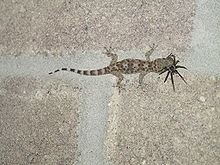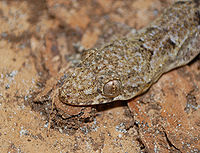- Common House Gecko
-
Common House Gecko 
Hemidactylus frenatus (Juvenile) Scientific classification Kingdom: Animalia Phylum: Chordata Class: Reptilia Order: Squamata Suborder: Sauria Family: Gekkonidae Genus: Hemidactylus Species: H. frenatus Binomial name Hemidactylus frenatus
Duméril & Bibron, 1836 [1]The Common House Gecko, scientific name Hemidactylus frenatus, is a native of southeastern Asia. It is also known as the Pacific house gecko, the Asian house gecko, or simply, the house lizard. They can be seen climbing walls of houses and other buildings in search of insects attracted to porch lights, hence their name. Spread around the world by ships, these geckos are now common in the southern half of the United States, large parts of tropical and sub-tropical Australia, and many other countries in South and Central America, Africa, Asia, and the Middle East. They grow to a length of between three to six inches (about 7.5–15 cm), and live for about five years.
A tropical gecko, Hemidactylus frenatus thrives in warm, humid areas where it can crawl around on rotting wood in search of the insects it eats. The animal is very adaptable and may prey on insects and spiders, displacing other reptiles.
Like many geckos, this species can lose its tail when alarmed. Its call or chirp rather resembles the sound "gecko, gecko". However, this is an interpretation, and the sound may also be described as "tchak tchak tchak" (often sounded three times in sequence). In Asia/South East Asia, notably Indonesia, Thailand, and Singapore, geckos have local names onomatopoetically derived from the sounds they make: Hemidactylus frenatus is called "chee chak" [2] or "chi chak" (pr: chee chuck), said quickly. Also commonly spelled as "cicak" in Malay dictionaries. In the Philippines they are called "butiki" in Tagalog, or "tiki" in Visayan, and in Thailand "jing-jok" (Thai: จิ้งจก). In India and Pakistan they are called "chhipkali"(Urdu:چہپکلی).
Contents
Description
Scan of the underneath side of a Mediterranean house gecko, showing good detail of skin and toepads. Chirping call of a Singapore house gecko or "cicak".
Chirping call of a Singapore house gecko or "cicak".
In this species, the snout is longer than the distance between the eye and the ear-opening, and is 1.3 to 1.5 times the diameter of the orbit. The forehead is concave and the ear-opening is small and roundish.
The body and limbs are moderately sized. The digits are moderately dilated and free; the inner one has a sessile claw. There are 4 or 5 lamelli under the inner digits, 7 or 8 (seldom 9) under the fourth finger, and 9 or 10 under the fourth toe.
The upper surfaces of the body are covered with small granules. The largest granules are on the snout; on the back these granules are intermixed with more or less numerous irregularly scattered round convex tubercles which are always much smaller than the ear-opening, and which are sometimes almost entirely absent.
The nostril is pierced between the rostral, the first labial, and three nasals. There are 10 to 12 upper and 8 to 10 lower labials. The mental is large, triangular or pentagonal. There are two or three pairs of chin-shields, the median is in contact behind the point of the mental.
The abdominal scales are moderate in size, cycloid and imbricate. The male has a series of 30 or 36 femoral pores, which are not interrupted on the preanal region.
The tail is rounded, feebly depressed, and covered above with very small smooth scales and six longitudinal series of keeled tubercles. The underside has a median series of transversely dilated plates. The tail serves in many species as an energy or fat like storage which the animal uses under abnormal feeding conditions. They are also used in territorial posturing, male house geckos lift their tails and vibrate it briefly to ward off other males. Though fragile, the tail regenerates to its original shape if detached.
The coloration of the animal is grayish or pinkish brown above. This tint can be uniform in color, or more or less distinctly marbled with darker markings. The head is generally variegated with brown. On the side of the head, a more or less defined brown streak, light-edged above, passes through the eye and in some individuals extends along the side of the body. The lower surfaces of the animal are whitish.[3]
Distribution
- Worldwide in tropical and subtropical regions.
- Philippines (Palawan, Panay, Calamian Islands, Luzon etc.), Japan (Ryūkyū, Bonin Islands).
- Polynesia, Micronesia (Caroline Islands: Pohnpei), Melanesia, Solomon Islands [McCoy 2000]
- Somalia (Lanza 1990).
- Madagascar, Mauritius, Reunion, Rodrigues, Comoro Islands (Mayotte), Nossi Be = Nosy Bé (probably Nosy Mitsio, Seychelles, India, Pakistan, Andaman Islands, Nicobar Islands, Bangladesh, Bhutan.
- Nepal, Sri Lanka, Maldives, Malaysia, Brunei, Burma (Myanmar) Vietnam, Thailand.
- Indonesia (Sumatra, Borneo, Java, Bali, Lombok, Sulawesi, Ambon.
- Australia (Cook Island, CKI, Northern Territory, coastal Queensland, coastal Northern New South Wales,South Australia, Western Australia, Norfolk Island).
- Western Samoa, New Caledonia.
- New Guinea, Fiji (introduced).
- Taiwan, China (Hong Kong, Hunan, Hainan, S Yunnan).
- El Salvador (HR 33: 65), Mexico (Yucatán and Baja California), Belize, Guatemala, Panama, Honduras [HR 31: 53; Isla de Utila: HR 32: 57], Costa Rica, Nicaragua, Venezuela (Falcon, Lara, Miranda, Monagas, Aragua, Carabobo).
- Introduced to Mariana Islands (Guam) and New Caledonia.
- Introduced to USA (Hawaii, Florida, Georgia, Texas, Mississippi, Louisiana, and Alabama).
- Starting to appear in England
- Introduced to Brazil
- Singapore (extremely common in urban high-rise apartment units)
- Also found in Israel
- Marshall Islands
House Geckos in Captivity
House Geckos can be kept as pets in a vivarium with a clean substrate, and typically require a heat source and a place to hide in order to regulate their body temperature, and a system of humidifiers and plants to provide them with moisture.
The species will cling to vertical or even inverted surfaces when at rest. In a terrarium they will mostly be at rest on the sides or on the top cover rather than placing themselves on plants, decorations or on the substrate, thus being rather inconspicuous.
Notes
- ^ "ITIS Standard Report Page: Hemidactylus frenatus". ITIS Report. ITIS-North America. http://www.itis.gov/servlet/SingleRpt/SingleRpt?search_topic=TSN&search_value=174056. Retrieved 2009-06-29.
- ^ Integr. Comp. Biol. - Search Result
- ^ Boulenger, G. A. (1890) Fauna of British India. Reptilia and Batrachia.
References
- Cook, Robert A. 1990 Range extension of the Darwin house gecko, Hemidactylus frenatus. Herpetofauna (Sydney) 20 (1): 23-27
- Darevsky I S; Kupriyanova L A; Roshchin V V 1984 A new all-female triploid species of gecko and karyological data on the bisexual Hemidactylus frenatus from Vietnam. Journal of Herpetology 18 (3) : 277-284
- Edgren, Richard A. 1950 Notes on the Neotropical population of Hemidactylus frenatus Schlegel Natural History Miscellanea (55): 1-3
- Edgren, R. A. 1956 Notes on the neotropical population of Hemidactylus frenatus Schlegel. Nat. Hist. Misc. 55: 1-3.
- Jerdon,T.C. 1853 Catalogue of the Reptiles inhabiting the Peninsula of India. Part 1. J. Asiat. Soc. Bengal xxii [1853]: 462-479
- McCoy, C. J.;Busack, Stephen D. 1970 The lizards Hemidactylus frenatus and Leiolopisma metallica on the Island of Hawaii Herpetologica 26 (3): 303
- Norman, Bradford R. 2003 A new geographical record for the introduced house gecko, Hemidactylus frenatus, at Cabo San Lucas, Baja California Sur, Mexico, with notes on other species observed. Bulletin of the Chicago Herpetological Society. 38(5):98-100 [erratum in 38(7):145]
- Ota H 1989 Hemidactylus okinawensis Okada 1936, junior synonym of H. frenatus in Duméril & Bibron 1836. J. Herpetol. 23 (4): 444-445
- Saenz, Daniel;Klawinski, Paul D. 1996 Geographic Distribution. Hemidactylus frenatus. Herpetological Review 27 (1): 32
External links
Categories:- Gekkonidae
- Reptiles of Asia
- Fauna of the Marshall Islands
- Reptiles of Thailand
- Reptiles of Japan
- Reptiles of Pakistan
- Reptiles of the Philippines
- Introduced reptiles of Hawaii
- Pet lizards
Wikimedia Foundation. 2010.




